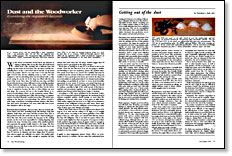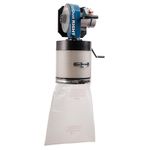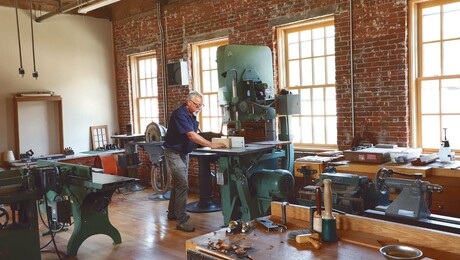
Synopsis: What woodworker doesn’t know the pleasure of wiping a delicate film of very fine dust off a well-waxed jointer bed? Kirk Kundtz, an internist and active woodworker, loves the feel of sawdust in any form, but his concerns about how it irritates the eyes and lungs led him to research its effects on the respiratory system. Here, he talks about how much has to be inhaled to be dangerous, explains the respiratory system, and how dust affects the lungs. He addresses woods that contain toxins, such as in red cedar. Side information by Theodore J. Fink, also an internist and also a woodworker, discusses how to decrease dust production, capture it, and protect your body from it with masks and goggles.
What serious woodworker doesn’t know the pleasure of wiping a delicate film of very fine dust off a well-waxed jointer bed? I like reaching into a tablesaw base and spilling out arm loads of wood dust onto my knees and the surrounding floor. In fact, I don’t mind dust in my hair, in my beard and in my pockets. And I’ve not only come to love the feel and sight of wood dust, but the satisfying aroma as well. I was first tempted to start woodworking when my best friend built a cedar porch swing for me-the air in his shop was filled with the rich scent of the wood. Since then, I’ve built my own shop and filled the air with dust from a dozen different woods, including sassafras, walnut, redwood, mahogany, teak, cherry, maple, oak and poplar.
Yes, the woodworker in me enjoys wood dust, but the doctor in me is suspicious because the dust so often irritates my eyes and lungs. My concerns led me to the hospital library to research woodworking’s effects on the respiratory system. What I found was both surprising and a little disconcerting. A computer search of medical literature revealed more than 250 articles pertaining to the hazards of woodworking. The articles covered a wide range of problems, including traumatic injuries, skin disorders and cancer associations, but most dealt with how wooddust inhalation affects the lungs.
How much dust is harmful?
Wood comes off tools in many different shapes and sizes, including broad, flat shavings; long, thin splinters; small chips; and coarse and fine powdery dust, such as that produced by the disc sander shown above. Hand-sanding produces fine dust. But power sanders, the big guns in the sanding arsenal, are the tools most responsible for creating lingering dust clouds in the shop. Powdery dust consists of the smallest particles and represents the greatest health hazard to the lungs. This fine powdery dust not only floats in the air for a long time, but it can be inhaled very deeply.
Dust particles can be classified into two groups: those smaller than 10 microns in diameter and those larger than 10 microns (one micron equals one millionth of a meter). The smaller particles are respirable: they are little enough to negotiate the tiny airways that reach deep into die lungs. Particles bigger than 10 microns tend to get trapped in the larger airways.
From Fine Woodworking #83
For the full article, download the PDF below:
Fine Woodworking Recommended Products

Rockler Dust Right 650 CFM

Shop Fox W1826

Rockler Dust Right 1250 CFM




















Log in or create an account to post a comment.
Sign up Log in